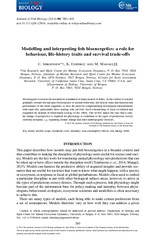| dc.contributor.author | Jørgensen, Christian | |
| dc.contributor.author | Enberg, Katja | |
| dc.contributor.author | Mangel, Marc | |
| dc.date.accessioned | 2016-09-27T09:22:59Z | |
| dc.date.available | 2016-09-27T09:22:59Z | |
| dc.date.issued | 2016-01 | |
| dc.Published | Journal of Fish Biology 2016, 8(1):389-402 | eng |
| dc.identifier.issn | 1095-8649 | en_US |
| dc.identifier.uri | https://hdl.handle.net/1956/12837 | |
| dc.description.abstract | Bioenergetics is used as the mechanistic foundation of many models of fishes. As the context of a model gradually extends beyond pure bioenergetics to include behaviour, life-history traits and function and performance of the entire organism, so does the need for complementing bioenergetic measurements with trade-offs, particularly those dealing with survival. Such a broadening of focus revitalized and expanded the domain of behavioural ecology in the 1980s. This review makes the case that a similar change of perspective is required for physiology to contribute to the types of predictions society currently demands, e.g. regarding climate change and other anthropogenic stressors. | en_US |
| dc.language.iso | eng | eng |
| dc.publisher | Wiley | en_US |
| dc.rights | Attribution CC BY | eng |
| dc.rights.uri | http://creativecommons.org/licenses/by/4.0/ | eng |
| dc.title | Modelling and interpreting fish bioenergetics: a role for behaviour, life-history traits and survival trade-offs | en_US |
| dc.type | Peer reviewed | |
| dc.type | Journal article | |
| dc.date.updated | 2016-08-05T12:15:41Z | |
| dc.description.version | publishedVersion | en_US |
| dc.rights.holder | Copyright 2015 The Authors | en_US |
| dc.identifier.doi | https://doi.org/10.1111/jfb.12834 | |
| dc.identifier.cristin | 1333096 | |

